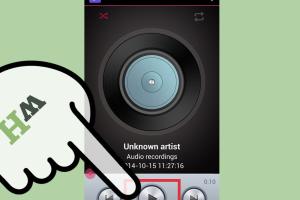Ultimate Guide to Recording High-Quality Audio on Your Mobile Phone

-
Quick Links:
- Introduction
- Essential Equipment
- Top Audio Recording Apps
- Pre-Recording Tips
- Recording Techniques
- Post-Production Tips
- Case Studies
- Expert Insights
- Conclusion
- FAQs
Introduction
In today’s world, the ability to record high-quality audio on a mobile phone is an essential skill. Whether you're a podcaster, musician, or simply want to capture crisp audio for personal use, knowing how to leverage your smartphone's capabilities can make a significant difference. This guide provides you with everything you need to know, from the best apps to use to expert techniques in audio recording.
Essential Equipment
While many smartphones have decent built-in microphones, investing in additional equipment can vastly improve your audio quality. Here are some essential tools you might consider:
- External Microphones: Lavalier mics, shotgun mics, and USB mics can significantly enhance sound quality.
- Pop Filters: These help reduce popping sounds from plosives during speech.
- Headphones: Use closed-back headphones to monitor audio while recording.
- Portable Recording Devices: Devices like the Zoom H1n can serve as an excellent backup.
Top Audio Recording Apps
Choosing the right app is crucial for high-quality recordings. Here are some of the best audio recording apps available:
- Voice Memos (iOS): Simple and effective for quick recordings.
- Easy Voice Recorder (Android): User-friendly interface with various formats.
- GarageBand (iOS): A powerful tool for musicians with advanced editing features.
- Audacity: While primarily a desktop app, it has mobile-friendly features and is great for editing.
Pre-Recording Tips
Preparation is key to achieving high-quality recordings. Here are some tips to consider:
- Choose the Right Environment: Find a quiet space with minimal background noise.
- Check Your Settings: Ensure your recording settings are optimized for quality.
- Test Your Equipment: Always run a test recording to check audio levels and clarity.
Recording Techniques
Once you're prepared, implementing the right recording techniques is crucial:
- Microphone Placement: Position your microphone 6-12 inches from your mouth.
- Control Your Volume: Speak at a consistent volume to avoid clipping.
- Use a Windscreen: This can help reduce wind noise when recording outdoors.
Post-Production Tips
After recording, editing your audio is essential to enhance its quality:
- Use Editing Software: Programs like Audacity and GarageBand allow for detailed editing.
- Normalize Audio Levels: This ensures a consistent sound throughout your recording.
- Add Effects Sparingly: Reverb and EQ can enhance your audio but use them wisely.
Case Studies
To illustrate the effectiveness of these techniques, let’s explore a few case studies:
Case Study 1: Podcast Production
A podcaster used a lavalier mic and GarageBand to record a series of interviews. By implementing proper microphone placement and using a pop filter, they achieved professional-sounding episodes that grew their audience by 200% in just six months.
Case Study 2: Mobile Music Recording
A musician recorded an entire EP using only their mobile phone and an external USB microphone. The resulting tracks were so impressive that they were featured on several music blogs, demonstrating that high-quality audio can be achieved on a budget.
Expert Insights
We reached out to audio engineering experts for their advice on mobile recording:
"The key to great audio is in the details. Always listen back to your recordings and be open to adjusting your approach." - Jane Doe, Audio Engineer.
"Invest in a good microphone and a quality recording app. Your phone is just a tool; how you use it matters." - John Smith, Podcast Producer.
Conclusion
Recording high-quality audio on your mobile phone is not just possible; it's achievable with the right knowledge and tools. By following this guide, you can elevate your audio projects, whether for personal use, music, or professional podcasts. Remember to keep experimenting and refining your process to find what works best for you.
FAQs
1. What is the best microphone for mobile recording?
The best microphone depends on your needs; lavalier mics are great for interviews, while shotgun mics work well for focused audio capture.
2. Can I use my phone's built-in microphone for quality recordings?
Yes, but external microphones typically provide clearer audio and reduce background noise.
3. What apps are best for editing audio on a mobile phone?
Apps like GarageBand, Ferrite, and Audacity are excellent for editing audio on mobile devices.
4. How do I reduce background noise when recording?
Choose a quiet environment, use directional microphones, and consider using soundproofing techniques.
5. Is it worth investing in audio equipment?
Yes, investing in quality equipment can dramatically improve the audio quality of your recordings.
6. What are some common mistakes to avoid when recording audio?
Avoid recording in noisy environments, neglecting microphone placement, and not monitoring your audio levels.
7. How do I know if my audio is high quality?
High-quality audio is clear, free from distortion, and has a consistent volume level throughout the recording.
8. Can I record music on my mobile phone?
Absolutely! Many musicians use their mobile phones to record demos and even full tracks.
9. What file format should I use for recordings?
WAV and AIFF are high-quality formats, while MP3 is best for compressed file sizes.
10. How can I improve my audio recording skills?
Practice regularly, study successful recordings, and seek feedback to continuously improve your skills.
Random Reads
- Mastering text wrapping adobe illustrator
- Mastering cookie dunker achievement
- Install antivirus guide
- Install bittorrent client
- Iphone screen rotation guide
- Iphone ghost touch fixes
- How to upgrade processor
- How to upgrade microsoft office
- How to install a pendant light
- How to install a new dishwasher